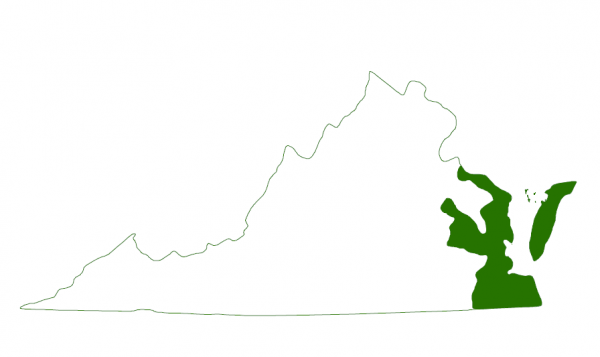Diamond-backed terrapins basking on mud flats. Photo credit: Barbara J. Saffir
Diamond-backed terrapin hatchling. Photo credit: Meagan Thomas
Adult female diamond-backed terrapin. Photo credit: Jason Crawley
Fact File
Scientific Name: Malaclemys terrapin terrapin
Classification: Reptilia, Order Testudines, Family Emydidae
Relatives: Diamond-backed-terrapins are the only species in the genus Malaclemys.
Conservation Status:
- Species of Greatest Conservation Need-Tier 2a on the Virginia Wildlife Action Plan
- Listed as an Appendix II species by CITES
Size: Female terrapins are larger than males and average around 6-9 inches long while males average between 4.5-5 inches in length.
Life Span: averages between 25-40 years in the wild, and possibly longer in captivity.
Identifying Characteristics
This is a moderate-sized estuarine turtle which is incredibly variable in coloration and pattern. Terrapins display female-biased sexual size dimorphism, meaning adult females are larger that adult males. The carapace is smooth, with the rear half of the shell the widest part. The carapace (upper shell) can be gray, brown, yellowish green, or nearly black, and has brown concentric circles alternating with gray, black, or yellow. The plastron (lower shell) is yellowish to greenish, and often has an irregular pattern of black flecks; it may have a dark brown blotch in each scute and the margins of the scutes may be outlined with thin black lines. The skin varies in shade from white to black, but is usually gray with an irregular pattern of small to large darker colored flecks. The eyes are black and the “lips” are yellow, occasionally presenting with a dark “moustache” above the mouth.
Habitat
The diamond-backed terrapin is the only exclusively estuarine turtle species in North America. It inhabits brackish water, saltwater estuaries and tidal marshes and can sometimes be seen in the Atlantic Ocean.
Diet
This is a carnivorous species which feeds on a variety of snails, bivalves, and crabs with salt marsh periwinkles (Littoraria irrorata) comprising the majority of their diet.
Distribution:
The diamond-backed terrapin is found in estuarine habitats along the U.S. Atlantic and Gulf coasts from Cape Cod, Massachusetts, to Corpus Christi, Texas, including the Florida Keys. In Virginia, this species is found in the Chesapeake Bay and its tidal tributaries as well as on the ocean side of the Eastern shore and southeast Virginia.

Role in the Web of Life
The diamond-backed terrapin is considered a keystone species due to its role as a predator of herbivorous invertebrates such as crabs and snails in salt marsh ecosystems across the east coast of the United States. It’s regulation of these organisms is critical to the maintenance of salt marsh plants and overall estuarine health in its native environment. Terrapins also ingest viable eelgrass seeds incidental to the consumption of prey items. These seeds are ultimately redistributed throughout the estuarine environment, playing an important ecological role of seed dispersal.
This species breeds and lays eggs in the spring and summer and mating always occurs in the water. Nests are usually constructed in sand, but may also be in fill dirt. These turtles typically overwinter in the mud within channels and tidal flats.
Last updated: August 14, 2024
The Virginia Department of Wildlife Resources Species Profile Database serves as a repository of information for Virginia’s fish and wildlife species. The database is managed and curated by the Wildlife Information and Environmental Services (WIES) program. Species profile data, distribution information, and photography is generated by the Virginia Department of Wildlife Resources, State and Federal agencies, Collection Permittees, and other trusted partners. This product is not suitable for legal, engineering, or surveying use. The Virginia Department of Wildlife Resources does not accept responsibility for any missing data, inaccuracies, or other errors which may exist. In accordance with the terms of service for this product, you agree to this disclaimer.

